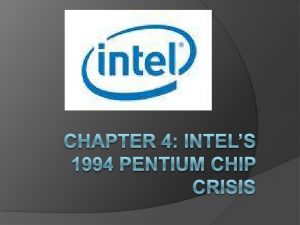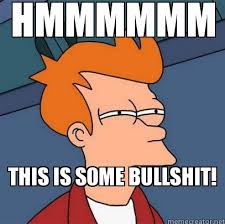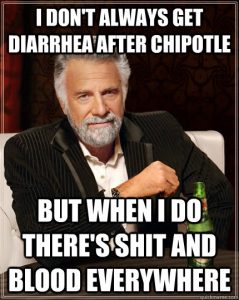In the summer of 1994, Intel types discovered a flaw with their Pentium computer chip, but thought the matter trivial; it was not publicly disclosed until Oct. 30, 1994, when a mathematician at Lynchburg College in Virginia, Thomas Nicely, posted a warning on the Internet.
 As perceived problems and complaints rose through the weekend Andrew S. Grove, Intel’s chairman and CEO, composed an apology to be posted on an Internet bulletin board—actually a web, but because he was at home with no direct Internet access, he asked Intel scientist Richard Wirt to post the message from his home account; But because it bore Mr. Wirt’s electronic address, the note’s authenticity was challenged, which only added to the fury of the Internet attacks on Intel.
As perceived problems and complaints rose through the weekend Andrew S. Grove, Intel’s chairman and CEO, composed an apology to be posted on an Internet bulletin board—actually a web, but because he was at home with no direct Internet access, he asked Intel scientist Richard Wirt to post the message from his home account; But because it bore Mr. Wirt’s electronic address, the note’s authenticity was challenged, which only added to the fury of the Internet attacks on Intel.
(I remember those days, and did live-post to my friends that had e-mail my 4th daughter’s 1995 home birth on a shitty Mac SE with a 20MB external hard drive for extra power.)
At 8 a.m. the following Monday inside the company’s Santa Clara, Calif. headquarters, Intel officials set to work on the crisis the way they attacked a large problems—like an engineering problem. Said Paul Otellini, senior vice-president for worldwide sales, “It was a classic Intellian approach to solving any big problem. We broke it down into smaller parts; that was comforting.”
By the end of week two, the crisis looked to be subsiding; Then on Monday, Nov. 12, 1994, the International Business Machines Corp. abruptly announced that its own researchers had determined that the Pentium flaw would lead to division errors much more frequently than Intel said. IBM said it was suspending shipments of personal computers containing the Pentium chip
Mr. Grove was stunned. The head of IBM’s PC division, Richard Thoman, had given no advance warning. A fax (remember those? Still required for certain transactions in Australia) from Thoman arrived at Intel’s HQ on Monday morning after the IBM announcement, saying he had been unable to find Grove’s number during the weekend. Mr. Grove, whose number is listed, called directory assistance twice to ask for his own number to ensure he was listed.
After the IBM announcement, the number of calls to Santa Clara overwhelmed the capacity of AT&T’s West Coast long-distance telephone switching centers, blocking calls. Intel stock fell 6.5 per cent.
As John Markoff of the N.Y. Times wrote on the front-page in Dec. 1994, the reluctance of Intel to act earlier, according to Wall Street analysts, was the result of a corporate culture accustomed to handling technical issues rather than addressing customers’ hopes and fears.
 Only then, Mr. Grove said, did he begin to realize that an engineer’s approach was inappropriate for a consumer problem.
Only then, Mr. Grove said, did he begin to realize that an engineer’s approach was inappropriate for a consumer problem.
According to one op-ed writer, Intel’s initial approach to the problem—prove you are doing sophisticated calculations if you want a replacement chip—was like saying “until you get to be cardinal, any internal doubts about the meaning of life are your own problem, a debate that has been going on since before Martin Luther.”
Intel’s doctrine of infallibility was facing an old-fashioned Protestant revolt.” (John Hockenberry, Pentium and our Crisis of Faith, N.Y. Times, Dec. 28, 1994, A11; this is how things were referenced before hot links)
Why and how did Intel go wrong? The answer was rooted in Intel’s distinctive corporate culture, and suggests that Intel went wrong in much the same way as other big and unresponsive companies before it.
Intel had traditionally valued engineering over product marketing. Inward-looking and wary of competitors (from experience with the Japanese) it developed a bunker mentality, a go-for-the-juglar attitude and reputation for arrogance.
According to one former engineer, Federico Faggin, a co-inventor of Intel’s first microprocessor, “The attitude at Intel is, ‘We’re better than everyone else and what we do is right and we never make mistakes.’”
Finally, on Dec. 20, Grove apparently realized that he and his company were standing at Ground Zero for an incoming consumer relations meteor. Intel announced that it would replace the defective chips—and pay for the labor—no questions asked, for the life of the original PC.
Discussing Intel’s previous position, Grove said, “To some people, this seemed arrogant and uncaring. We apologize for that.”
So what did a consumer with a Pentium do: Teach Intel that this isn’t about a white paper. It’s about green paper—the money you paid and the performance you didn’t get. Replace that chip. After all, consumers deserve to be treated with respect, courtesy and a little common sense.
Now apply all of that Intel stuff to Chipotle.
They even took out a full-page ad to apologize, just like Intel, but people still read newspapers 20 years ago. Today, the strategy seems hopelessly out of touch for a tragically hipster company.
 Chipotle is the opposite, focusing too much on consumer whims and not enough on food science, and now it’s going to get worse.
Chipotle is the opposite, focusing too much on consumer whims and not enough on food science, and now it’s going to get worse.
An official chronology of the Simi Valley Norovirus outbreak involving Chipotle Mexican Grill customers and employees, which has been obtained by Food Safety News, shows there were far more victims than were reported at the time.
The report shows the Simi Valley outbreak was larger than any of the other four outbreaks Chipotle has suffered since July, including the ongoing Norovirus outbreak mostly involving Boston College students, the two E. coli outbreaks and the Salmonella Newport outbreak in Minnesota in August. Together these events have sickened more than 490 people.
The County’s chronology includes detailed tracking of the complaints as they came in and as the illnesses were confirmed as Norovirus victims. From that first report through Sept. 25, 2015, the chronology comes to this conclusion: ”The total number of reportedly ill customers and employees at this Chipotle outbreak investigation is 234.”
The number of victims was being reported in other media at the time as just 98.
And, the internal document says the real number of victims of Chipotle’s Simi Valley outbreak could be higher still. “In reviewing the food logs provided by Chipotle for both 8/18/15 and 8/19/15, it is estimated at least 1500+ entrees were sold each day.” Sandy Murray, who did the analysis for the division, wrote: “Thus, the actual number of customers and employees ill from this outbreak is likely to be substantially higher than the reported number of 234.”
In 2015, Chipotle ran print advertisements in 60 newspaper markets with an apology from Steve Ells, the burrito chain’s founder and co-chief executive. His apology though only went to the victims of the current nine state E. coli 026 outbreak and the Boston College outbreak.
“From the beginning, all of our food safety programs have met or exceeded industry standards,“ Ells said (Pinto defense). “But recent incidents, an E. coli outbreak that sickened 52 people and a Norovirus outbreak that sickened approximately 140 people at a single Chipotle restaurant in Boston, have shown us that we need to do better, much better.”
No mention was made of the other foodborne outbreaks.
Now it’s Facebook’s turn: The full-page apology adverts in newspapers in the U.S., UK and Germany ran on Sunday (Mar. 25, 2018).
But, the polls say consumers are turning away from facebook, not by immediately terminating their accounts, but by slowly disengaging.
Fewer than half of Americans trust Facebook to obey U.S. privacy laws, according to a Reuters/Ipsos poll released on Sunday, while a survey published by Bild am Sonntag, Germany’s largest-selling Sunday paper, found 60 percent of Germans fear that Facebook and other social networks are having a negative impact on democracy.
Facebook founder and chief executive Mark Zuckerberg apologized for “a breach of trust” in advertisements placed in papers including the Observer in Britain and the New York Times, Washington Post and Wall Street Journal.
“We have a responsibility to protect your information. If we can’t, we don’t deserve it,” said the advertisement, which appeared in plain text on a white background with a tiny Facebook logo.
The newspapers are happy for the revenue, but if only Facebook had a way to reach out to its 2 billion or so customers rather than newspapers.
Australian rockmelon growers could learn a thing or two. I can’t keep giving out this free advice forever, but the public citizen in me and my values compel me to do so.
Rebels without a clue.
